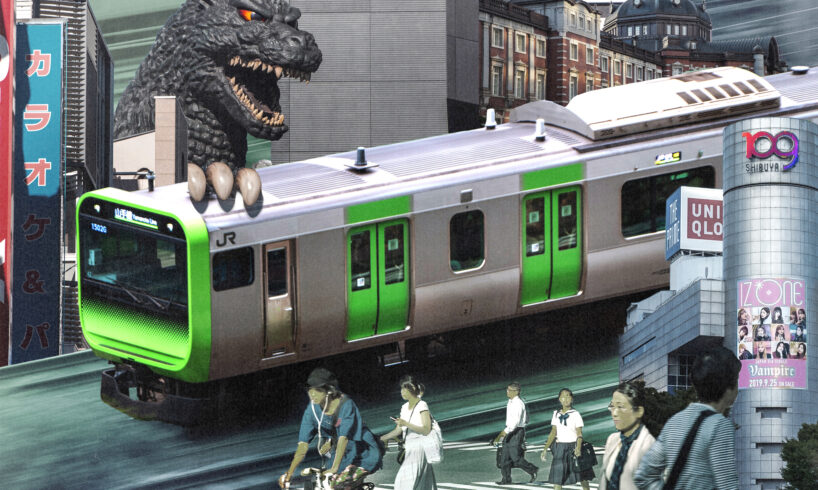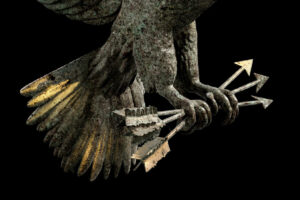
The Yamanote line is often referred to as Tokyo’s most famous train line. Easily identifiable by its lime-green colorway, the train line loops around the city’s major shopping districts, cultural landmarks and more, stopping at stations like Shinjuku, Shibuya and Harajuku. We know that first-time visitors will head to these areas despite the crowds; so we’ve compiled a beginner’s guide to Yamanote Line’s most iconic stations, including which spots to prioritize, and which you might want to skip.
If you’re keen to discover less-crowded areas with unique charm on the train line, make sure to also check out our guide to the Yamanote Line’s hidden gems.
Shibuya Scramble Crossing | Image: Airbreaker ZH
Shibuya
Perhaps one of the most photographed areas in all of Tokyo, Shibuya is a major commercial and entertainment center known for its iconic Scramble Crossing. Offering countless options for shopping, dining and nightlife, the area is a capsule of modern Japanese culture in all its intensity.
Spots To Visit in Shibuya
Shibuya Scramble Crossing: Yes, it is going to be extremely crowded and overwhelming, but the crossing is still worth seeing if you’re in the area, especially after dark. The zig-zagging zebra crossings are smaller in scale than you might imagine, so it’ll only take a few minutes to check it out, unless you’re determined to get a photo. Just be mindful not to disturb pedestrians actually trying to cross the street.
Miyashita Park: This multi-level shopping complex with a cool, modern rooftop park is a good spot to take a break and get refreshments. Although it is always decently crowded, the mall has plenty of outdoor spaces that make it feel less claustrophobic when compared to Shibuya Scramble Square mall, which is directly connected to Shibuya Station.
Spots To Skip in Shibuya
Shibuya Sky Observation Deck: Located atop the Shibuya Scramble Square building, the deck offers a panoramic view of Tokyo. Although the views are stunning, sunset slots are notoriously hard to reserve, and you’re almost guaranteed to face huge crowds. If you’re simply after a beautiful city view, check out the Tokyo Government Building Observation Deck in Shinjuku (free) or the Roppongi Hills City View (less crowded).
Hachiko Statue: The small bronze statue, which memorializes the touching tale of the loyal Akita dog, has always been a popular meeting spot and photo spot — which means it’s always surrounded by chaos. Just skip it, unless you’re a huge fan of the story.
Meiji Jingu Shrine | Image: James Pere
Harajuku
Harajuku has a long and colorful history as the city’s hub of “kawaii” culture, and is also known as the birthplace of many legendary streetwear brands. The station is in close proximity to the beautiful Meiji Jingu Shrine and the lively Yoyogi Park, which offer moments of peace away from Harajuku’s bustling streets.
Spots To Visit in Harajuku
Meiji Jingu Shrine: The grand Shinto shrine, dedicated to Emperor Meiji and Empress Shoken, is not only a meaningful cultural site but also a breathtaking natural sanctuary in the city. Home to Japan’s first “eternal forest,” with trees planted by 110,000 volunteer citizens, the shrine is a tranquil place of reverence and beauty.
Yoyogi Park: When the weather is nice, this sprawling, free-to-enter park is the perfect place to wind down with a cup of coffee or picnic food.
Laforet Harajuku: If you’re on the hunt for unique, contemporary Japanese fashion brands, you must check out this multi-story shopping complex. Its entrance is right next to the iconic Vivienne Westwood store.
Ura-Harajuku: Often referred to as “Ura-Hara” (back Harajuku), this network of backstreets and alleys around Cat Street are packed with one-of-a-kind boutiques, thrift shops, galleries and coffee shops.
Spots To Skip in Harajuku
Takeshita Street: This narrow pedestrian street is one of Harajuku’s defining sites, dotted with trendy boutiques, shops and street food. However, it has become near impossible to navigate without rubbing shoulders with millions of tourists, and much of what originally made the street so iconic — the eclectic, quirky styles and subcultures — have faded significantly over the years. Unless you’re desperate to go to a pet cafe (some of which have highly questionable ethics) or a specific store on the street, maybe pass.
Omotesando: Often called Tokyo’s Champs-Élysées, the tree-lined avenue houses glamorous high-end stores, like the museum-like Ralph Lauren flagship and gorgeous Dior and Hermés branches. However, the avenue gets extremely crowded, especially as you get closer to the Harajuku side. Unless you’re on the hunt for a specific fashion item, it may not be worth jostling past the hoards of people. The same shops in Ginza are a bit more spaced out, which might make your shopping experience less congested.
Shinjuku Omoide Yokocho | Image: Pema G
Shinjuku
Even if you’re not staying on the Yamanote Line, you’ll probably end up at Shinjuku — one of the busiest stations in the world. Shinjuku is a massive, multifaceted urban center that is almost a city in itself, containing multiple major department stores, nightlife district, towering skyscrapers and more.
Spots To Visit in Shinjuku
Shinjuku Gyoen National Garden: A huge, serene green oasis in the heart of Shinjuku, Shinjuku Gyoen is famous for its blend of three distinct garden styles: traditional Japanese, English Landscape and French Formal. It gets very crowded during cherry blossom season, but we highly recommend strolling around at any other time of the year.
Isetan Shinjuku Store: Alongside the historic department stores of Tokyo’s east side, like Nihonbashi Takashimaya and Ginza Mitsukoshi, Isetan Shinjuku is one of the city’s most gorgeous and luxurious department stores. Even if you’re not buying anything, it’s fun to walk around and admire the beautiful homeware, clothing stores and the extensive lineup of confectionery in the basement floor.
Tokyo Metropolitan Government Building: If you’re looking for city views without insane crowds, this is an underrated (and free) observation deck. You might even catch Mount Fuji in the distance on a clear day!
Omoide Yokocho: as you might guess, this narrow path named “Memory Lane” — lined with yakitori stands, izakaya joints and other food stalls — is mostly filled with tourists at this point. But it’s still worth walking through it if you’re in Shinjuku, especially at night when the lanterns are lit up. Just don’t expect an authentic local experience.
Spots To Skip in Shinjuku
Kabukicho and Golden Gai: Tokyo’s red-light district, Kabukicho, is infamous for scamming tourists to enter bars with huge cover charges and expensive drinks. It’s not the nicest area to be in especially after dark, so unless you’re really into the nightlife there, we recommend skipping it. Golden Gai, the most touristy street of small bars in the area, is often mentioned online but not worth venturing to if you want a more authentic experience (instead, check out our video guide to bar hopping in Shimbashi).
Don Quijote: Most tourists pay a visit to the miscellaneous goods store to shop for souvenirs and knick-knacks, but we suggest avoiding the Shinjuku branch, as it will likely be congested at any given time.
The Tokyo Station Building | Image: Yoshihiro
Tokyo Station
One of Japan’s central transportation hubs, Tokyo Station is distinguished by its magnificent, red-brick Marunouchi Station Building, which serves as the gate for the shinkansen (bullet train) network. The surrounding Marunouchi district is home to a forest of sleek skyscrapers, high-end shopping complexes and the tranquil, historic Imperial Palace.
Spots To Visit near Tokyo Station
Museums and Galleries: Not many tourists know that there are some world-class cultural institutions right near Tokyo Station: Artizon Museum, which houses ancient to contemporary Japanese art; Mitsubishi Ichigokan Museum, a restored Meiji-era architectural gem; and Tokyo Station Gallery, a gorgeous space located within the historic Tokyo Station Marunouchi Building. These indoor spaces make for the perfect rainy-day activity.
Imperial Palace East Garden: The Imperial Palace East Garden is a large, free public park in the center of Tokyo that occupies the historical site of the inner circles of Edo Castle. Though the main structures are gone, visitors can explore original moats and stone walls, climb the foundation of the former castle tower, and enjoy the beautifully preserved Ninomaru Japanese Garden.
Tokyo International Forum: A must-visit spot for architecture enthusiasts, this convention and arts center is known for its striking, glass-and-steel structure, designed by Uruguayan architect Rafael Viñoly.
Spots To Skip near Tokyo Station
Tokyo Character Street & Tokyo Ramen Street: These concentrated shopping areas within the Tokyo Station underground allow for efficient sampling if you’re already in the station to travel somewhere, but we wouldn’t recommend going out of your way to stop by. You can find the same character goods and food offerings at other, less crowded areas in the city.
Shinobazu Pond in Ueno Park
Ueno
Ueno is a great area to visit for a change of pace, especially for families with children. Ueno Park, one of Japan’s first public parks, is home to multiple famed museums and cultural institutions, like the Tokyo Metropolitan Festival Hall. The expansive park also includes a zoo, and is surrounded by various long-established eateries. Check out our extensive guide to the area.
Spots To Visit in Ueno
Tokyo National Museum: As Japan’s oldest and largest museum, Tokyo National Museum houses an unparalleled collection of Japanese art and antiquities. The Honkan (Japanese Gallery) houses a chronological display of Japanese art from prehistoric times to the 19th century, including Jomon-era figurines and samurai armor.
Tokyo Metropolitan Art Museum: Established in 1926 as Japan’s first public art museum, the institution houses a rotating selection of special exhibitions with masterpieces from Japan and abroad (e.g. a Joan Miró retrospective, works from the Van Gogh family collection).
Shinobazu Pond and Surroundings: Located at the southern end of Ueno Park, this tranquil pond features a lush lotus pond, a boat pond for paddling and a cormorant pond that serves as a bird sanctuary. The Bentendo Temple, which stands in the middle of the lotus pond, is definitely a highlight of the picturesque scene.
Spots To Skip in Ueno
Ueno Zoo: While it is an affordable and accessible activity for families, it might not be worth the trek if you’re short on time. As it’s a long-established zoo, some of the enclosures and exhibits tend to be outdated.
The Park, during Cherry Blossom Season: We would recommend avoiding the area all together during peak cherry blossom season, as the crowds can get overwhelming. There are less crowded areas to enjoy cherry blossoms all around the city.
Related Posts
Discover Tokyo, Every Week
Get the city’s best stories, under-the-radar spots and exclusive invites delivered straight to your inbox.
Updated On October 23, 2025





